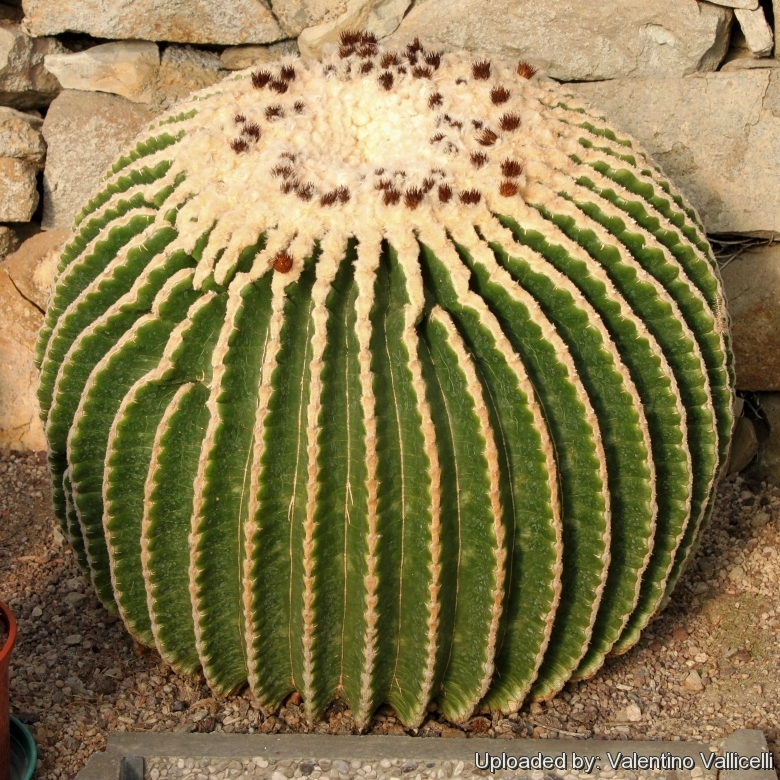
Echinocactus grusonii var. subinermis Photo by: Valentino Vallicelli
Origin and Habitat: Garden origin (Nursery produced cultivar)
Synonyms:
See all synonyms of Echinocactus grusonii
Description: 'brevispinus' warrants no varietal taxonomic ranking, as it is a recent mutant which occurred in cultivation.
This plant differs from the common Golden barrel cactus (Echinocactus grusoniiSN|3345]]SN|3345]]) only for the very short spines. Except for the spines it is identical in shape and size to the standard species. It has a single slowly growing globe-shaped stem that became elongated (barrel-shaped) in maturity, up to 90cm (180cm) in height and spread. This stem is pale green and heavily ribbed with numerous areoles sprouting radial, yellow spines. They normally offset with advanced age and a few multiples occur even at small sizes.
Flowers: The flowers are produced from end of spring to summer only on larger mature specimens receiving enough full sun. Flower are diurnal, vivid yellow (4-5 cm wide) and form a circular ring at the top of the plant, but are not very visible being small in relation with the size of the barrel, and lost into the creamy coloured wool at the plant apex.
Subspecies, varieties, forms and cultivars of plants belonging to the Echinocactus grusonii group
 Echinocactus grusonii Hildm.: It produces slowly growing barrel-shaped stem up to 90 cm (180 cm) in height and spread. The stem is pale green and heavily ribbed with very numerous areoles and golden yellow spines.
Echinocactus grusonii Hildm.: It produces slowly growing barrel-shaped stem up to 90 cm (180 cm) in height and spread. The stem is pale green and heavily ribbed with very numerous areoles and golden yellow spines. Echinocactus grusonii var. albispinus Y.Itô: It looks just like a regular "Golden Barrel" but the spines are glassy-white instead of yellow.
Echinocactus grusonii var. albispinus Y.Itô: It looks just like a regular "Golden Barrel" but the spines are glassy-white instead of yellow. Echinocactus grusonii var. albispinus f. cristatus hort.: crested form with spines all white instead of yellow.
Echinocactus grusonii var. albispinus f. cristatus hort.: crested form with spines all white instead of yellow. Echinocactus grusonii f. cristatus hort.: This is a wavy crested form with golden-yellow spines. It can also get very big making a spectacular specimen.
Echinocactus grusonii f. cristatus hort.: This is a wavy crested form with golden-yellow spines. It can also get very big making a spectacular specimen. Echinocactus grusonii var. intermedius hort.: This plant differs from the common Golden Barrel Cactus for the spines that are stout but intermediate in length between the standard from and the short spined type "subinermis" (syn: brevispinus).
Echinocactus grusonii var. intermedius hort.: This plant differs from the common Golden Barrel Cactus for the spines that are stout but intermediate in length between the standard from and the short spined type "subinermis" (syn: brevispinus).- Echinocactus grusonii var. intermedius f. cristatus hort.: Strong crested form with stout spines that are intermediate in length between the standard from and the short spined type "subinermis" (syn. brevispinus).
 Echinocactus grusonii var. intermedius f. variegatus hort.: Yellow and green, variegated plants with short, spines that are intermediate in length between the standard from and the short spined type "subinermis" (syn. brevispinus).
Echinocactus grusonii var. intermedius f. variegatus hort.: Yellow and green, variegated plants with short, spines that are intermediate in length between the standard from and the short spined type "subinermis" (syn. brevispinus). Echinocactus grusonii var. intertextus Y.Itô: (a.k.a "Krauskopf" or "tortulispinus") This plant differs from the common Golden barrel cactus for the spines, that are yellowish-white, sparse, flattish, curved to almost crinkled backward and very irregular, 2 to 6 cm long.
Echinocactus grusonii var. intertextus Y.Itô: (a.k.a "Krauskopf" or "tortulispinus") This plant differs from the common Golden barrel cactus for the spines, that are yellowish-white, sparse, flattish, curved to almost crinkled backward and very irregular, 2 to 6 cm long. Echinocactus grusonii var. intertextus f. cristatus hort.: Crested form with characteristich curved spines, that are flattish, almost crinkled backward and very irregular.
Echinocactus grusonii var. intertextus f. cristatus hort.: Crested form with characteristich curved spines, that are flattish, almost crinkled backward and very irregular. Echinocactus grusonii f. monstruosus cristatus hort.: Crested form of the mostrose cultivar covered by white wool with short yellow spines. The crests are quite unstable
Echinocactus grusonii f. monstruosus cristatus hort.: Crested form of the mostrose cultivar covered by white wool with short yellow spines. The crests are quite unstable Echinocactus grusonii f. monstruosus hort.: Free offsetting small form covered by yellowhish-white wool with short yellow spines. The rib structure is not yet apparent, and they have pronounced tubercles making them look superficially like Mammillarias.
Echinocactus grusonii f. monstruosus hort.: Free offsetting small form covered by yellowhish-white wool with short yellow spines. The rib structure is not yet apparent, and they have pronounced tubercles making them look superficially like Mammillarias. Echinocactus grusonii var. setispinus f. minor cristatus hort.: This is the tiniest crested form. A dwarf form covered by touch friendly spines and looking quite dissimilar to the standard species.
Echinocactus grusonii var. setispinus f. minor cristatus hort.: This is the tiniest crested form. A dwarf form covered by touch friendly spines and looking quite dissimilar to the standard species. Echinocactus grusonii var. setispinus f. minor mostruosus cristatus cv. Scarascia: The plant forms lots of tiny monstrous wooly heads, that time by time begin to crest.
Echinocactus grusonii var. setispinus f. minor mostruosus cristatus cv. Scarascia: The plant forms lots of tiny monstrous wooly heads, that time by time begin to crest. Echinocactus grusonii f. setispinus hort.: This cultivar has very thin acicular spines, that become longer as the plant ages.
Echinocactus grusonii f. setispinus hort.: This cultivar has very thin acicular spines, that become longer as the plant ages. Echinocactus grusonii var. subinermis Y.Itô: (a.k.a. "cv. TOGENASHI KINSHACHI", "inermis" or "brevispinus") This is very short spined mutantant. Except for the spines it is identical in shape and size to the standard species.
Echinocactus grusonii var. subinermis Y.Itô: (a.k.a. "cv. TOGENASHI KINSHACHI", "inermis" or "brevispinus") This is very short spined mutantant. Except for the spines it is identical in shape and size to the standard species. Echinocactus grusonii var. subinermis f. cristata hort.: This is the crested form of the short-spined Golden Barrel. This crest can also get very large
Echinocactus grusonii var. subinermis f. cristata hort.: This is the crested form of the short-spined Golden Barrel. This crest can also get very large
Bibliography: Major references and further lectures
1) Edward F. Anderson “The Cactus Family” Timber Press, 2001
2) James Cullen, Sabina G. Knees, H. Suzanne Cubey “The European Garden Flora Flowering Plants: A Manual for the Identification of Plants Cultivated in Europe, Both Out-of-Doors and Under Glass”Cambridge University Press, 11/Aug/2011
3) David Hunt, Nigel Taylor “The New Cactus Lexicon” DH Books, 2006 ISBN 0953813444, 9780953813445
4) Walther Haage “Kakteen von A bis Z” Neumann Verlag, 1981
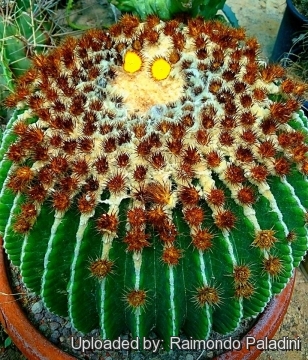 Echinocactus grusonii var. subinermis Photo by: Raimondo Paladini
Echinocactus grusonii var. subinermis Photo by: Raimondo Paladini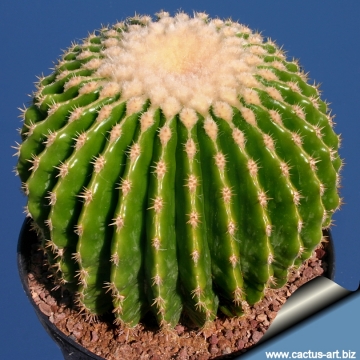 Echinocactus grusonii var. subinermis Photo by: Cactus Art
Echinocactus grusonii var. subinermis Photo by: Cactus Art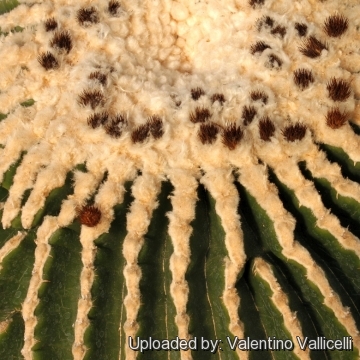 Echinocactus grusonii var. subinermis Photo by: Valentino Vallicelli
Echinocactus grusonii var. subinermis Photo by: Valentino Vallicelli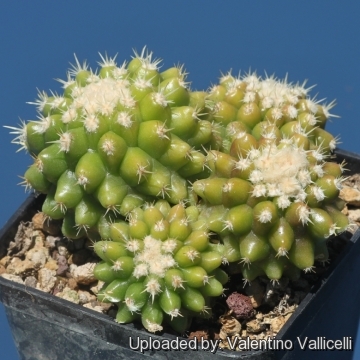 Echinocactus grusonii var. subinermis Photo by: Valentino Vallicelli
Echinocactus grusonii var. subinermis Photo by: Valentino Vallicelli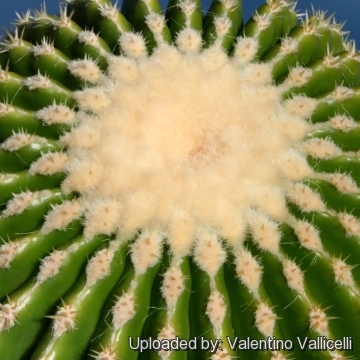 Echinocactus grusonii var. subinermis Photo by: Valentino Vallicelli
Echinocactus grusonii var. subinermis Photo by: Valentino Vallicelli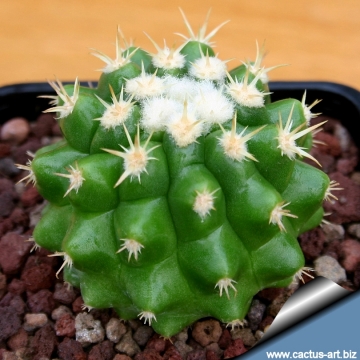 Echinocactus grusonii var. subinermis Photo by: Cactus Art
Echinocactus grusonii var. subinermis Photo by: Cactus Art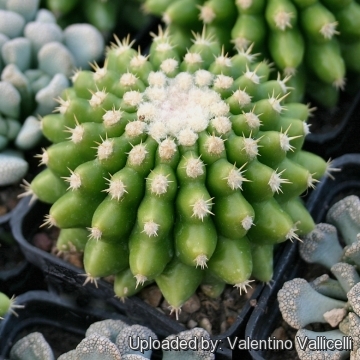 Echinocactus grusonii var. subinermis Photo by: Valentino Vallicelli
Echinocactus grusonii var. subinermis Photo by: Valentino Vallicelli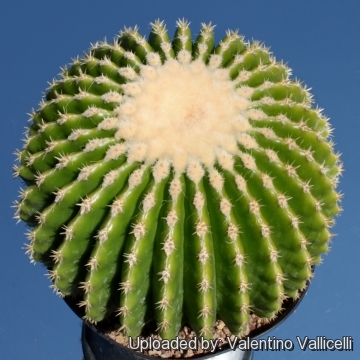 Echinocactus grusonii var. subinermis Photo by: Valentino Vallicelli
Echinocactus grusonii var. subinermis Photo by: Valentino VallicelliCultivation and Propagation: Frost tender but resistant to very dry conditions, Cold hardiness increases with improved drainage, so keep plants as dry as possible in winter. They grow best in well-drained soil and in a position with full sun, which will help to maintain the lustre of the spines and longevity of the flowers. Provide the plant with extremely well-drained soils, as the plants are subject to crown and soft rot if they remain too moist. Besides, it performs wonderfully in containers, Container media should be coarse as well. Young plants are prone to mealy bug and red spider mite. Propagate from cuttings or seed.
Propagation: From seeds. E. grusonii will produce hundreds of fruits each season. Several months after the flower dies off and the pods are ripen it is possible to collect them from under the dried flower. The pods will come off with a slight twist, leaving the wool on the cactus. Use a knife to slice down one side of the pod to expose the seed and scrape them out. The seeds are mahogany or reddish amber and tiny. Then place the seeds in some water to soak overnight. Fill germination trays with a well blended mixture of 60% peat moss 40% vermiculite and one to one part of coarse sand or pumice. Use a horse syringe to suck the small seeds and some of the water into the syringe. With the syringe, distribute the seeds evenly in the germination tray, shaking the syringe so the seeds don't settle at the bottom and all come out at once. Some growers also recommend to cold-stratify seeds in a refrigerator for a year prior to sow them. But can also be used dry seeds too. Place then the trays in filtered sun, cover with a glass sheet and keep the soil moist until the seeds germinate in approximately 2 to 6 weeks. They will look like small spheres, red in colour not green. Then gradually remove the glass cover. When the small cacti start to sprout tiny spines, use a pair of tweezers to transfer them from the propagation trays into 5 cm pots filled with the same soil mix used in the germination trays. Allow the small cacti to grow for about one/two year and then move the cacti to 10 cm pots and allow them to grow further.
Your Photos
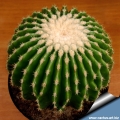
by Cactus Art



















